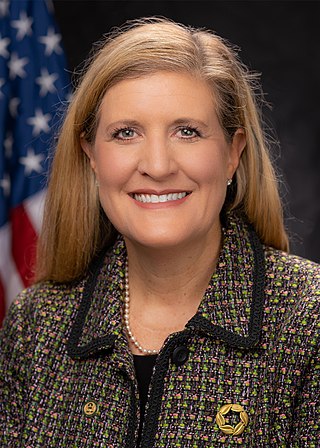
Edmund Sixtus Muskie was an American statesman and political leader who served as the 58th United States secretary of state under President Jimmy Carter from 1980 to 1981, a United States senator from Maine from 1959 to 1980, the 64th governor of Maine from 1955 to 1959, and a member of the Maine House of Representatives from 1946 to 1951. He was the Democratic Party's nominee for vice president in the 1968 presidential election.

United States environmental law concerns legal standards to protect human health and improve the natural environment of the United States. While subject to criticism at home and abroad on issues of protection, enforcement, and over-regulation, the country remains an important source of environmental legal expertise and experience.
In the United States, a citizen suit is a lawsuit by a private citizen to enforce a statute. Citizen suits are particularly common in the field of environmental law.

The United States Department of Justice Environment and Natural Resources Division (ENRD) is one of seven litigating components of the U.S. Department of Justice. ENRD's mandate is to enforce civil and criminal environmental laws and programs protecting the health and environment of the United States, and to defend suits challenging those laws and programs.

The University of Oregon School of Law is a public law school in the U.S. state of Oregon. Housed in the Knight Law Center, it is Oregon's only state funded law school. The school, founded in 1884, is located on the University of Oregon campus in Eugene, on the corner of 15th and Agate streets, overlooking Hayward Field.

The Clean Air Act (CAA) is the United States' primary federal air quality law, intended to reduce and control air pollution nationwide. Initially enacted in 1963 and amended many times since, it is one of the United States' first and most influential modern environmental laws.
The Tulane Environmental Law Clinic (TELC) is a legal clinic that Tulane Law School has operated since 1989 to offer law students the practical experience of representing real clients in actual legal proceedings under state and federal environmental laws.

United States v. Weitzenhoff, 35 F.3d 1275 is a legal opinion from the Ninth Circuit Court of Appeals that addresses the confusing mens rea requirement of a federal environmental law that imposed criminal sanctions on certain polluters. The main significance of the court's opinion was that it interpreted the word "knowingly" in the statute to mean a general awareness of the wrongfulness of one's actions or the likelihood of illegality, rather than an actual knowledge of the statute being violated. Circuit Court Judge Betty Binns Fletcher authored the majority's legal opinion in this case.

John C. Dernbach is a nationally and internationally recognized authority on sustainable development, climate change, and environmental law. He is Commonwealth Professor of Environmental Law and Sustainability at Widener University Commonwealth Law School and Director of its Environmental Law and Sustainability Center.
Environmental Defense v. Duke Energy Corporation, 549 U.S. 561 (2007), is a United States Supreme Court case in which the Court held that while a term may be used more than once in a statute, an agency has the discretion to interpret each use of the term in a different way based on the context. It involved the Environmental Defense Fund and Duke Energy. In a unanimous decision, the court held in favor of the plaintiff's argument.
Ecology Law Quarterly is an environmental law review published quarterly by students at the UC Berkeley School of Law. The journal also produces Ecology Law Currents, an "online companion journal designed to publish pieces on a more frequent basis than the print journal."
The Harvard Environmental Law Review is a student-run law review published at Harvard Law School. The journal publishes articles, notes, and comments on subjects relating to environmental law, land-use law, and the regulation of natural resources.

Alexandra Dapolito Dunn is an American environmental lawyer and law professor, specializing in chemical and pesticide regulation, water quality issues, water treatment issues, urban development, rule of law, environmental justice, environmental conflict resolution, cooperative federalism, and implementation of the Clean Water Act and the Frank R. Lautenberg Chemical Safety for the 21st Century Act. Dunn was an executive at several environmental management associations, and served as Regional Administrator for New England in the US Environmental Protection Agency (EPA), and Assistant Administrator for EPA's Office of Chemical Safety and Pollution Prevention.
Environs: Environmental Law and Policy Journal, is a student-run law review published twice per year at the University of California, Davis School of Law. The journal primarily covers environmental law and policy and related subjects with a regional focus in California.
The UCLA Journal of Environmental Law and Policy is a student-run law review published at the University of California, Los Angeles, School of Law. The journal primarily publishes articles and comments discussing environmental law and policy and related subjects.
The Stanford Environmental Law Journal is a student-run law review published at Stanford Law School that covers natural resources law, environmental policy, law and economics, international environmental law, and other related disciplines.
The Journal of Environmental Law and Litigation is a student-run law review published at University of Oregon School of Law. The journal publishes articles and essays about environmental law, natural resources law, and litigation relating to these fields.
The Michigan Journal of Environmental & Administrative Law is a student-run law review published at the University of Michigan School of Law. The journal publishes articles, notes, comments, and essays relating to administrative and environmental law.
The Columbia Journal of Environmental Law is a student-run law review published at Columbia University's School of Law. The journal primarily publishes articles, notes, and book reviews discussing environmental law and policy and related subjects.
The New York University Environmental Law Journal is a student-run law review published at the New York University School of Law. The journal primarily publishes articles and notes that discuss topics involving environmental law, land-use law, and other related disciplines.








